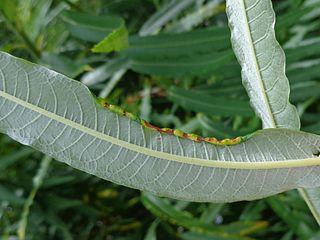Related Research Articles
Michael Chinery is an English naturalist.

Alucita hexadactyla is a "micromoth" of the many-plumed moth family (Alucitidae). It is found in Eurasia. It was previously thought to also occur in North America, but a 2004 study showed that the North American species are distinct and separate.

Taphrina alni is a fungal plant pathogen that causes alder tongue gall, a chemically induced distortion of female alder catkins.

Vasates quadripedes, the maple bladder-gall mite, is an eriophyid mite in the genus Vasates, which causes galls on the leaves of silver maple, red maple (A. rubrum), and sugar maple (A. saccharum). The gall is rounded, sometimes elongate, and has a short, thin neck. Typically, galls are 2–3 millimetres (0.079–0.118 in) in diameter, and may be numerous on the upper surfaces of leaves. They have an opening in the lower surface. At first they are yellowish-green or bright red, later they become dark red and black.

Aceria fraxinivora, also known as the cauliflower gall mite and the ash key gall, causes the growths, known as galls, found on the hanging seeds or "keys" of the ash (Fraxinus) species.

Andricus aries is a species of gall-forming wasps, in the genus Andricus. The species was named by the French entomologist Joseph-Étienne Giraud, in 1859. It is commonly found in eastern Europe and during the 21st century has spread to western Europe.

Psyllopsis fraxini is a psyllid which lives within a gall on ash.

Rabdophaga rosariella is a species of gall midge which forms galls on sallows. It was first described by Jean-Jacques Kieffer in 1897.

Rabdophaga marginemtorquens is a gall midge which forms galls on willows and is found in Europe. It was described by Johann Jacob Bremi-Wolf in 1847.

Iteomyia major is a gall midge which forms galls on willows. It was first described by Jean-Jacques Kieffer in 1889.

Iteomyia capreae is a gall midge which forms galls on willows. It was first described by Johannes Winnertz in 1853.

Aculus laevis is a species of mite which causes galls on the leaves of sallows. It was first described by Alfred Nalepa in 1892.

Phyllocoptes goniothorax is a species of mite belonging to the genus Phyllocoptes, which causes galls on the leaves of hawthorns. It was first described by Alfred Nalepa in 1889.

Andricus corruptrix is a species of gall-forming wasp, in the genus Andricus. It is found in Europe.

Eriophyes laevis is a gall mite which makes small, pimple-like galls on the leaves of alder. The mite was first described by the Austrian zoologist, Alfred Nalepa in 1889 and is found in Europe and North America.

Aceria nervisequa is a species of mite that belongs to the family Eriophyidae. It is found in Europe and was first described by Giovanni Canestrini in 1891. The mite causes galls on the leaves of beech,
Acalitus calycophthirus is an eriophyid mite which causes big bud galls on birch twigs. It is found in Europe and was first described by the Austrian zoologist, Alfred Nalepa in 1891.
Massalongia rubra is a species of gall midge which forms galls in the leaves of birch. It was first described by the French naturalist and entomologist, Jean-Jacques Kieffer in 1890 and is found in Europe.
Spanioneura fonscolombii, is a species of plant-parasitic psyllid in the family Psyllidae which feed on box. It was first described by Arnold Förster in 1848 and is found in Europe. It is also found in the United States of America where it was accidentally introduced.

Eriosoma ulmi, the elm-currant aphid, is a species of aphid in the family Aphididae found in Asia and Europe. It is a true bug and sucks sap from plants. It was described by Carl Linnaeus in his Systema Naturae, published in 1758. The mite causes abnormal plant growths, known as galls on their primary host, elm trees (Ulmus species). To complete there life-cycle they feed on a secondary host, the roots of currant bushes.
References
- ↑ "The British Plant Gall Society" . Retrieved 28 November 2019.
- 1 2 "Plant galls in Cornwall & the Isles of Scilly" (PDF). Archived from the original (PDF) on 16 February 2015. Retrieved 4 September 2014.